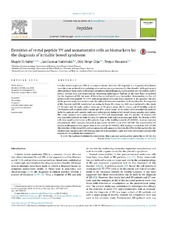Densities of rectal peptide YY and somatostatin cells as biomarkers for the diagnosis of irritable bowel syndrome
Peer reviewed, Journal article
Published version

Åpne
Permanent lenke
https://hdl.handle.net/1956/11456Utgivelsesdato
2015-03-09Metadata
Vis full innførselSamlinger
Originalversjon
https://doi.org/10.1016/j.peptides.2015.02.008Sammendrag
Irritable bowel syndrome (IBS) is a common chronic disorder. IBS diagnosis is a diagnosis of exclusion since there are no blood tests, radiological or endoscopic examinations for this disorder. Although several attempts have been made to develop a symptoms-based diagnosis, such systems are not widely used in clinics. Several tests and examinations measuring pathological findings in IBS have been considered for the diagnosis of IBS, but none of them has proved useful as a biomarker. Abnormalities in the cell densities of rectal peptide YY (PYY) and somatostatin cells have been reported in IBS patients. The aim of the present study was to determine the utility of these abnormalities as biomarkers for the diagnosis of IBS. Patients with IBS established according to Rome III criteria (n = 101) were included in this study (71 females and 30 males with a mean age of 35 years; range 18–61 years), and 62 healthy subjects (38 females and 24 males with a mean age of 41 years; range 18–65 years) were recruited as controls. Both the patients and controls underwent colonoscopy during which rectal biopsy samples were taken. The tissue samples were immunostained for PYY and somatostatin, and the number of stained cells was quantified relative to both the area of epithelial cells and per microscopic field. The density of PYY cells was significantly lower in IBS patients than in the healthy controls (P < 0.0001); receiver operator characteristic (ROC) analysis revealed an area under the ROC curve (AUC) of 0.99. The somatostatin cell density in IBS patients was higher than in the controls (P < 0.0001); ROC analysis revealed an AUC of 0.86. The densities of the rectal PYY and somatostatin cells appear to be clinically effective biomarkers for IBS. Furthermore, measurement of these parameters is inexpensive, rapid and does not require considerable experience or sophisticated equipment.
